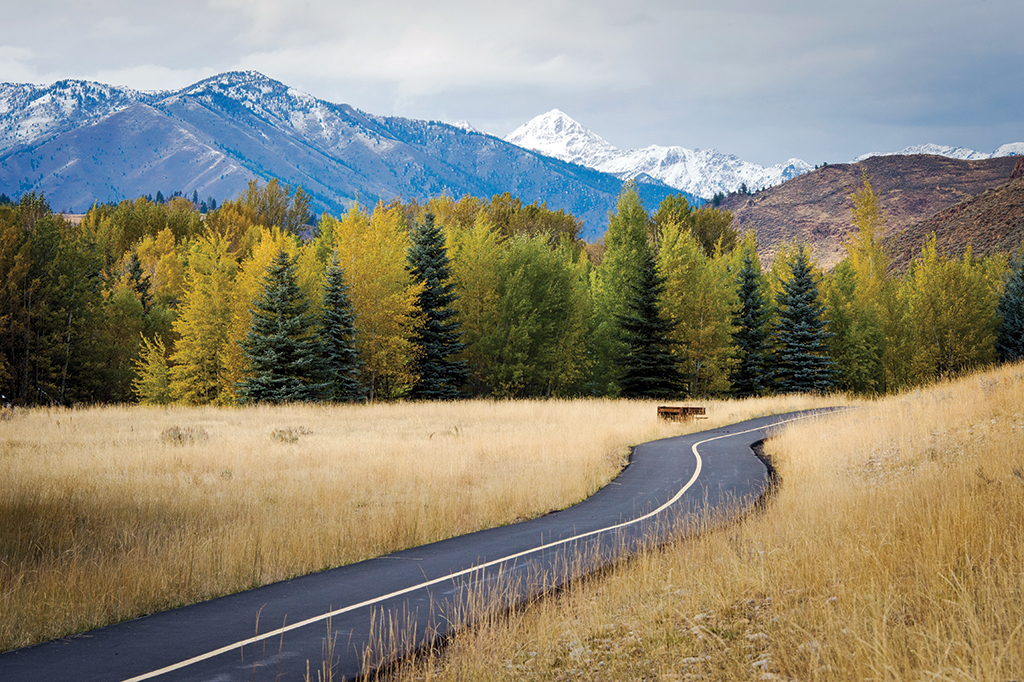In a Valley where there are literally thousands of miles of trails, one of the most notable trails is the Wood River Trail (WRT), more well-known to locals as ‘The Bike Path.” It’s a conversion of the old railroad tracks into over 20-plus miles of paved, multi-use, year-round path that provides a non-motorized connection between the Wood River Valley communities of Ketchum, Sun Valley, Hailey, and Bellevue, and to public lands and trails nearby. Commuters, bikers, joggers, walkers, skate boarders, horseback riders, and even cross-country skiers and snowshoers in the winter—you name it, everyone enjoys the Wood River Trail in all seasons and every day of the year—for free. Dotted with interpretive signs, doggie water fountains, benches to sit on and enjoy the view … it’s not your average walk in the park, and in many ways, it’s the outdoor lifeline in our valley.
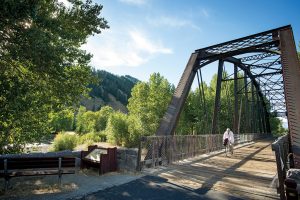
Spring – the WRT crosses several historic railroad bridges along its 20-mile route
And yet, the nationally-renowned interconnected trail system that the Wood River Valley now boasts, including the central artery of the WRT, was not an easy feat to bring to fruition. It is the legacy of the vision, drive, and hard work of trailblazing local leadership and community efforts. In the case of the WRT, it all started when a railroad trestle bridge blew out in the early 1970s.
In 1972, Union Pacific officially abandoned the Sun Valley rail line after a trestle bridge just north of River Run was damaged to the point of needing complete replacement. Railroad officials originally wanted $20 million for the railroad right-of-way, and at first, it was meant to be for the highway. At the time, Idaho Transportation Department (ITD) was going through a huge growth period and hosted a community meeting at the old Holiday Inn to present their plan to acquire the railroad right-of-way and build a separated four-lane highway from Bellevue to Ketchum. The Valley’s population came “unglued,” to the extent that individuals chained themselves to cottonwood trees in protest with slogans of “Don’t Widen Our Highway!”
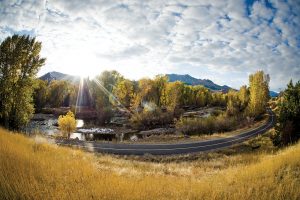
Fall – the autumn colors are spectacular, especially where the trail follows the Big Wood River.
Local attorney Russ Pinto saw the perfect opportunity to instead acquire the railroad right-of-way to establish a connected path for recreation users and non-motorized transportation. Pinto began working with a small group in town doing research on the right-of-way and talking to ITD, as well as ranchers who had been involved in the established “Sheep Driveway” that was dedicated in the valley in 1929 as a stock driveway for sheep and cattle. Pinto began initiating negotiations with ITD and the ranchers with the idea of a connecting greenway belt from Ketchum to Bellevue, similar to the Sheep Driveway, but designed for recreational use.
Meanwhile, Bob Rosso, owner since 1976, with his wife Kate, of outdoor store and community hub The Elephant’s Perch, and Butch Harper, the Ketchum Ranger District Recreation Manager from 1964-1994, were working together to create what would become the Blaine County Recreation District (BCRD). Established in 1976, the BCRD offered local programs such as basketball, baseball, and volleyball for the community in the early years, but Rosso and Harper were enamored with idea of a rails-to-trails project connecting the entire valley (at the time recreation users had to share the right of way with a busy highway). The BCRD took the initiative on.
Then, “Along came Mary.” Young, energetic, and all-in, Mary Austin Crofts applied for the BCRD executive director job and was hired in 1984. At the time, the E.D. was the sole employee at the BCRD, which was directed by a board that included Rosso and Harper.
For the next seven years, Mary Austin Crofts didn’t take a day off. She ran the BCRD and helped coordinate the rails-to-trails initiative. “It was just such a great team of people! We had this deep friendship and camaraderie right from the very start,” she exalted. “It wasn’t as easy as people often think. In the early stages, there was a lot of push back. People didn’t want a public path in their backyards, people worried about theft and crime increasing—every single section has a story of adversity in its making. Now, we’re all so grateful to have it, but we have it because everybody pushed so hard to make it happen.”
Austin Crofts, Rosso, and Harper worked extensively with local attorneys Russ Pinto and Jim Speck, and engineer Dick Fosbury, along with members of local and state government. But at first, the idea of the Wood River Trail was a hard sell to the “masses” in Ketchum.
Butch Harper recounted, “At first, we got the right-of-way to develop a paved trail from Adams Gulch Road to Saddle Road on the north side of town. So we decided, ‘People have no idea what this is going to be like, so let’s just do it and build it, so people will understand what we’re trying to do.’ Then people saw it, and used it, and that was really the kick off. So many people were saying, ‘Wow, this is really cool! Now we see what you’re talking about,’ and it got a lot easier after that.’”
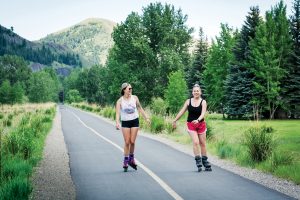
Summer – expect to see dog walkers, baby joggers, roller bladers, runners, and bikers during the busy summer months.
Sometime after that first trail, local citizens passed a bond (with 95% support) to allocate $3 million to complete portions of the bike path and Austin Crofts successfully applied for funding to build the two tunnels under the highway.
Harper remembered how important community involvement was to success, recounting, “From the Forest Service standpoint, the amount of volunteer help we had to do these things was huge. Whenever you put the word out, people showed up to do the work and we just got a lot of stuff done. It was a long period of time, and it all didn’t happen at once. It took a lot of effort, commitment, and time and this community would still step up again if you had the right project.”
It was also noted by the team that it was easier to get things done back in that day. Harper laughed saying, “At the Forest Service, we’d just design trails, put out to volunteers that we needed a hand, and then people would show up and we’d build a trail. Now, we’d go to jail if we did that.”
“Back then, it was easier,” described Rosso. “ Now it gets a little more complicated as we all need to think ‘how do we retain these amenities that do belong to the people of the valley and that escalate guests’ experiences when they come visit?”
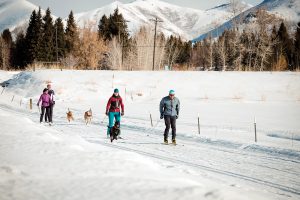
Winter – the WRT is regularly groomed with classic and skate tracks, and is dog-friendly.
At last count, the Wood River Trail boasted over 300,000 users. Many describe it as “saving us during COVID.” Austin Crofts is in the beginnings of writing and producing a coffee table book filled with stories and photographs commemorating the history of the community’s “bike path” and is currently rallying funding for the effort. “This trail system is my passion,” she said, “it was complex and there were many times it looked impossible. But, we did it.”
The BCRD “A Team” as they were called, were also able to negotiate, acquire funding for, and develop the North Valley Trails ski system and the Harriman Trail Pathway between Galena Lodge and the Sawtooth National Recreation Headquarters and to purchase and upgrade Galena Lodge. The Wood River Trail became a quick model for other mountain towns across the West to develop rails-to-trails greenways.
“People in this valley love their trails,” grinned Bob Rosso. “So many people worked their tail off to get what we have and are still working their tails off. Now, a lot of us are getting to be old farts, but we don’t want to watch the things we have in this Valley fade away. What comes with what we have is the protection of them. If we build them and don’t take care of them, they’ll get trashed—we’ve got to take care of it all. It’s also never done, the question for all of us in the Valley is, what’s next? What are we going to do for the community?”


